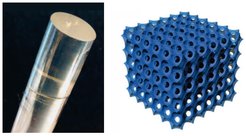Nanotechnology in a Glass Sponge
Monorhaphis chuni produces a spicule with a perfect periodic
arrangement of nanopores

Materials scientists resolve many problems by following the example of nature – and sometimes they don’t realize this until after the fact. Take, for example, the synthetic nanoporous materials with potential applications in biomedicine, sensors and chemical catalysis. Their structure is similar to that of the glass rod or spicule, around a centimeter thick and up to three meters in length, that supports the sea sponge Monorhaphis chuni. And they are produced in a similar way.
These similarities in structure and production have been identified by a team at the Max Planck Institutes of Colloids and Interfaces and Microstructure Physics. M. chuni wraps silicate – that is, glass – around regularly arranged silicatein proteins. These proteins then fill the pores, which are around 5 nanometers in size. This creates a structure that resembles a stack of cartons containing eggs. The eggs represent the protein molecules, while the cartons represent the glass.
For certain technical applications, silicate structures are already being assembled around droplets of fat. However, the resultant materials exhibit a pore size that isn’t as uniform as the protein-filled cavities in the spicule of M. chuni.
(Advanced Materials, December 12, 2013)
